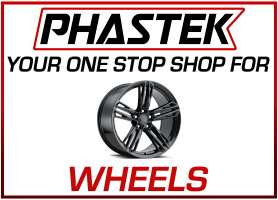
The 2013 Chevy Camaro 1LE was born from complaints from only 2 percent of Camaro drivers. These drivers, Chevy said, were as concerned with the way the Camaro handled a racetrack as they were with it looking like a Transformer. With its 6.2-liter, 426-horsepower V8, the current Chevy Camaro SS has motor for days. Doesn’t it make sense to offer a handling pack to put it to use? And besides, Ford offers a track pack on the Mustang.
To get the performance it wanted out of the 1LE, Chevy gave it new gearing via a Tremec TR6060-MM6 six-speed manual with liquid-to-air cooling, a 3.91 final drive, thicker stabilizer bars, monotube rear dampers, a strut tower brace, ZL1 wheel bearings and a ZL1 fuel pump. Finally, and perhaps most importantly, Chevy wrapped the 20-by-10-inch front and rear wheels in super-sticky 285/35ZR20 Goodyear Eagle F1 Supercar G:2 tires.
Chevy says this setup should be good for 1.0g of lateral acceleration and a “sub-3-minute lap at Virginia International Raceway’s Grand Course.” We didn’t have access to VIR, but we do have a skid pad, a quarter-mile and a slalom. How did Chevy’s track-focused Camaro do when pushed to the limit?
Vehicle: 2013 Chevy Camaro 1LE
Odometer: 1,601
Date: 4/2/2013
Driver: Chris Walton
Price: $37,035 (base)
Specifications:
Drive Type: Front engine, rear-wheel drive
Transmission Type: Six-speed manual
Engine Type: Naturally aspirated, port-injected V8, gasoline
Displacement (cc/cu-in): 6,162/376
Redline (rpm): 6,250
Horsepower (hp @ rpm): 426 @ 5,900
Torque (lb-ft @ rpm): 420 @ 4,600
Brake Type (front): 14-inch ventilated discs with four-piston fixed calipers
Brake Type (rear): 14.4-inch ventilated discs with four-piston fixed calipers
Suspension Type (front): Independent MacPherson struts with dual lower ball joints, coil springs, twin-tube dampers, stabilizer bar
Suspension Type (rear): Independent multilink, coil springs, monotube dampers, stabilizer bar
Tire Size (front): 285/35ZR20 (100Y)
Tire Size (rear): 285/35ZR20 (100Y)
Tire Brand: Goodyear
Tire Model: Eagle F1 Supercar G:2
Tire Type: Summer performance
As Tested Curb Weight (lb): 3,880
Test Results:
Acceleration
0-30 (sec): 2.1 (2.1 w/ TC on)
0-45 (sec): 3.2 (3.3 w/ TC on)
0-60 (sec): 4.8 (5.0 w/ TC on)
0-60 with 1-ft Rollout (sec): 4.6 (4.8 w/ TC on)
0-75 (sec): 6.8 (7.0 w/ TC on)
1/4-Mile (sec @ mph): 13.0 @ 108.7 (13.2 @ 108.0 w/ TC on)
Braking
30-0 (ft): 26
60-0 (ft): 108
Handling
Slalom (mph): 71.1 w/ TC on (70.8 w/ TC in dynamic)
Skid Pad Lateral Acceleration (g): 0.97 w/ TC on (0.96 w/ TC in dynamic)
Db @ Idle: 50.4
Db @ Full Throttle: 82.6
Db @ 70-mph Cruise: 73.9
RPM @ 70: 1,750
Comments:
Acceleration: The launch control is easy to access, but it would be better described as an “anti-embarrassment” button. It essentially lets the car leave the line without stalling or spinning the tires. It doesn’t provide the optimal launch and even pulls throttle down well into the upper part of 1st gear. A reasonably skillful driver will beat it every time with the traction control disabled. The clutch pedal is light-ish, swings without varying effort, but engages near the top of travel. Transmission lever both up/downshifts with some effort, but also with solid assurance you’re in the gear you’ve selected. No crunchy synchros or problems at all and no apparent heat-soak issues, as trap speed stayed steady or even increased from first to last runs. Sounds fantastic.
Braking: Near zero dive, no wiggle, straight as an arrow with ultra-mild distance creep after a handful of runs. Second stop was shortest of five total that only grew by a couple feet.
Handling:
Slalom: As frustrating as Camaros are to slalom purely because of the dreadful visibility they offer, this one is extremely capable as long as you can avoid mowing cones. The tires (and ESC “Competitive mode”) both allow a large envelope in which to play. Super-mild understeer on the limit can be mitigated with momentary lift-throttle or, as I discovered on one blazing fast (and utterly anomalous) pass with ESC fully on, by the stability system. I couldn’t re-create it, but it was quicker than I was with it in Comp mode (essentially off). Quick turn-in, rear stays planted unless prodded, and easy to controllably slide at the exit.
Skid pad: Again, super mild understeer on the limit, plenty of grip all around, but only a modest amount of info coming through the steering wheel and again, limited visibility.
SOURCE: EDMUNDS










Facebook
Twitter
Instagram
YouTube
RSS